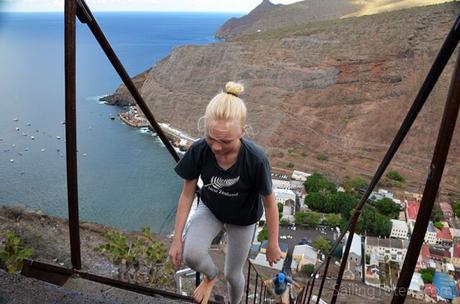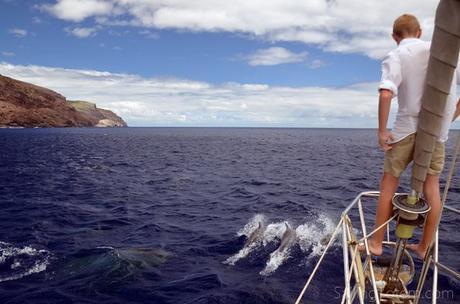

On one hand, St Helena is an obvious choice for boats heading NW from Cape Town: it’s along the path of a logical route, whether you are pointing to Brazil or to the Caribbean. So it’s surprising that quite a few of the boats passing through during our two week stay were doing just that: a night or two, then casting off again, as if they just wanted a notch for their binnacle. The island has so much to offer, and it’s worth a longer stay!

What will you love?
Dramatically beautiful
St Helena reminds me of my hometown of San Francisco in a way: around every corner, at the top of every hill, there is another view that takes your breath away. The rich reds woven through the dry rocky coastline, verdant green fields and the cloud forest upland. You go in minutes from an apocalyptic moonscape to the garden of Eden.

Packed full of history
On St Helena, you walk in the footsteps of ghosts, and not just Napoleon’s. In the garden of “The Castle,” (what’s the castle?), a plaque commemorates a 1898 speech in the location given by none other than Joshua Slocum…my inspiration for cruising.
At one time, 1,000 ships per year called into St Helena, as an important watering and provisioning spot between Europe and the “far east”. Sailors suffering from scurvy were unloaded to recover or die. Slaves and indentured servants by the tens of thousands were here: as captives, as emancipated (but not truly liberated) subjects, and finally as freed people. More than 8,000 passed through encampments that sound little better than concentration camps. The lichen-covered rocks alongside nearly every road and mossy path, recalled their labor. It’s not uplifting, but it’s important to remember and respect.
Hiking hiking hiking
Like you don’t already need massive exercise ahead of sitting on your tush during passages…St Helena is a hiker’s paradise, with dozens of marked trails and more for the adventurous overland rambler. The biggest problem is just getting to them (infrequent public busses with difficult to interpret routes; prohibitively expensive taxis).

An annual festival of walking was on during our visit, so we lucked into a series of guided hikes. They were led by islanders well informed on the history of the land, biologists eager to share information about endemic species and the threats or challenges they face.

The day before we left was the Coast to Coast hike: a walk from Sandy Bay, on the east side, to Jamestown, on the west. Can’t think of a better way to stretch our legs before doing a whole lot of sitting on the passages ahead!

Obligatory: climbing the 699 steps of Jacob’s Ladder, for a birds-eye view of Jamestown below. Siobhan does this hike, and all the others, barefoot.

What’s not so great?
I’ve said that I fall in love with every place we visit, and it’s true. But taken as I am with St Helena, not everything about it is awesome.
Formalities aren’t cheap considering most cruisers stop in for only a week or two. Visas are free for 3 days; £17 (about $25) per person for longer stays. Port fees run £40 ($60) for Totem. Moorings are £2 or £3 ($3-4.50) per day, depending on the size. Water taxi, £2/person round trip (younger kids half price); sometimes a convenience, sometimes the ONLY way to get ashore (especially if your dinghy is too heavy to pick up onto the wharf).

So for a couple of weeks, the basics are setting us back about $300! But although it’s a lot, it’s not so much we’d pass St Helena by: chalked up as the price of admission for a special place. Topping up our diesel, on the other hand, was truly painful. Oil prices down worldwide? No sign of that here…we had to pay $7.20 per gallon. OUCH.
It’s not surprising that things cost a little more here- most imports are from the UK (via cargo to Cape Town, then the RMS) or South Africa. In the shops, prices actually weren’t as bad as I expected, given the journey that goods must take.

That cabbage in the corner? SEVEN DOLLARS.
There are some bargains. Gorgeous fresh yellowfin tuna, a few bucks per pound. This gorgeous burger at Anne’s was a bargain at $4.50.

The bigger problem is availability. It was great after the RMS ‘St Helena’ called in and cargo found its way onto store shelves. But most cruisers are accustomed to the guideline of buying something they want as soon as they see it, since it may be gone tomorrow.
If there’s a swell running, the anchorage can get a little uncomfortable. On the other hand, there are very stout, relatively new moorings now, although we’ve heard first hand from boats that had problems with them – a dive on ours made Jamie comfortable. But the surge on some days can make landing on the wharf in your own dinghy can be truly treacherous, and I’m grateful for the water taxi drivers who skillfully take us safely ashore.
Getting online is also a costly proposition, at £6.60 (about $10) an hour for ssslllooowwww internet that sometimes just stops working (while you continue to tick away $1 every 6 minutes). But hey, we’re in the middle of the South Atlantic on a satellite connection! Flashbacks to our arrival in the Marquesas, six years ago…of course it’s slow and expensive.
Learning more
Here are a handful of resources to read before coming to St Helena, or offer tales live a little vicariously (missing a favorite? Tell me in the comments or send a note).
Books to read:
Outposts: Journeys to the Surviving Relics of the British Empire. Simon Winchester visits more than a dozen British dependencies, including St Helena (and Ascension, and Chagos, and other places on our route), in an oddly nostalgic but interesting series of reflections.
Black Rock. Author Louise Hoole first came to St Helena as a child when her family moved there from the UK, and it dug into her heart. This work of fiction is in the voice of St Helena’s most famous former resident—Napoleon—and spins a vivid angle on some of the controversy surrounding his death on the island: natural causes or not? Her well-researched storytelling brings St Helenian history to life.
Websites and feeds to check out: OK…I’ll apologize that the links are then here for now… yes, you might have to use The Google. But the internet here is so bad today (see above) that I couldn’t finish pulling them myself. Yup, that bad!
What The Saints Did Next. while looking for information and ideas to inform our stay on St Helena. We met with the couple who are behind this site. As travelers AND locals, they have distilled information that’s great to prep visitors, like top sights to fit into a weeklong stay. I especially loved their online magazine, Breeze, and the more detailed look it offers into Saints and their island home.
St Helena Tourism (government). The tourism website isn’t just a lightweight rah-rah visitors site: it’s packed with information on everything from Saints slang to endemic species. The tourism office in Jamestown was a huge help after we arrived, too: arranging our day tour, helping us with a whale shark trip, and generally being incredibly helpful (thank you Shelley, Helena, Juliette, Z…. !).
Saint Helena Trust (nonprofit). On the Trust website are a series of downloadable PDFs on a range of historic topics of interest. They are geared for middle schoolers, but great reading for just about anyone.
SAMS / The Sentinel and The Independent / Saint radio. These are the two local media outlets, each with a newspaper, affiliated radio stations and some social media channels. Want to know what’s happening? See what people on the island car about? These are a great peek into what matters to Saint Helenians, and also a good way to find out what’s on (like the Marine festival that took place the day before our departure).
Wheres_domino. What’s not to love about a live-tweeting whale shark? In a project by the Georgia Aquarium, a few of the massive fish have been tagged and broadcast their position when they surface.


